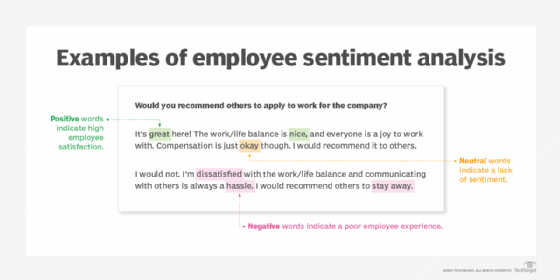
employee sentiment analysis
What is employee sentiment analysis?
Employee sentiment analysis is the use of natural language processing (NLP) and other artificial intelligence (AI) techniques to automatically analyze employee feedback and other unstructured data to quantify and describe how employees feel about their organization.
Employee sentiment analysis is a specific application of sentiment analysis, which is an NLP technique designed to identify the emotional tone of a body of text. Sentiment analysis, also known as opinion mining, is widely used to detect how customers feel about products, brands and services.
Employee sentiment analysis can make an organization aware of its strengths and weaknesses by gauging its employees. This can provide organizations with insight into positive and negative feelings workers hold toward the organization, its policies and the workplace culture.
Organizations typically collect feedback through standardized or open-ended employee surveys that are conducted periodically to detect changes in employee satisfaction and other perceptions over time. These surveys also measure employee experiences that HR leaders can use to address employee issues, improving the overall employee experience.
Employee sentiment analysis requires a comprehensive strategy for mining these opinions -- transforming survey data into meaningful insights.
Why is employee sentiment analysis important?
As employee turnover rates increase, annual performance reviews and surveys don't provide enough information for companies to get a true understanding of how employees feel.
That's where employee sentiment analysis comes in. Employee sentiment analysis provides several important capabilities, including the following:
- Helps companies take the necessary steps toward change. When companies discover that employees are dissatisfied with how they're handling key issues such as employee performance, productivity and customer service, their HR leaders can take action.
- Encourages transparency and more open communication. When companies takes corrective actions to reassure employees that their opinions matter, it results in transparency, better communication and higher employee engagement.
- Provides an accurate picture of employee opinions. People learn about the least desirable companies to work for from former and current employees. Employee sentiment analysis can help organizations evaluate whether these opinions are based on inaccurate perceptions. If an inaccurate opinion is harming the company's image, HR personnel can take action to foster more positive impressions.
How does employee sentiment analysis software work?
To gather and analyze employee sentiment data at a sufficiently large scale, many organizations turn to employee sentiment analysis software that uses AI and machine learning to automate the process.
The organization first sends out open-ended surveys that employees can answer in their own words. Then NLP tools review each answer, analyzing the sentiment behind the words and providing a detailed report to managers and HR.
The software uses NLP to determine whether the sentiment in combinations of words and phrases is positive, neutral or negative and applies a numerical sentiment score to each employee comment.

After these scores are aggregated, they're visually presented to employee managers, HR managers and business leaders using data visualization dashboards, charts or graphs. Being able to visualize employee sentiment helps business leaders improve employee engagement and the corporate culture. They can also use the information to improve their performance management process, focusing on enhancing the employee experience.
Organizations can also program sentiment analysis tools to determine how engaged their employees are throughout the day; this gives organizations a way to gauge employee sentiment more often than just sending out annual surveys. For example, email-based sentiment analysis can identify exact words and phrases and help infer insights gleaned from departmental-level or individual emails. Companies can then use this data to address specific issues or introduce company-wide changes.
How can employee sentiment analysis change HR?
Human resources has historically relied on quantitative and highly structured data mainly gleaned from payroll systems and other core HR sources. The problem is there's only so much insight HR can distill from numbers.
Employee sentiment analysis, however, enables HR to make use of the organization's unstructured, qualitative data by determining whether it's positive, negative or neutral and to what extent.
Qualitative data includes comments, onboarding and offboarding feedback, probation reviews, performance reviews, policy compliance, conversations about employee goals and feedback requests about the business.
Employee sentiment analysis enables HR to more easily and effectively obtain useful insights about what employees think about the organization by analyzing how they communicate in their work environment. This lets HR keep a close eye on employee language, tone and interests in email communications and other channels, helping to determine if workers are happy or dissatisfied with their role in the company.
Employee sentiment analysis tools
The following are examples of employee sentiment analysis software:
- AskNicely software tracks employee and customer sentiment, enabling managers to support employees based on customer feedback and help them improve the customer experience. The tool integrates with platforms including HubSpot, Microsoft Dynamics and Salesforce.
- Intellica.AI from Intellica Labs is a machine learning platform organizations can use to develop a wide range of applications, such as AI-driven chatbots, signature verification, sentiment analysis and brand analytics for marketing campaigns. It uses such technologies as NLP, text processing and deep learning to automate employee sentiment analysis. Companies can use the software to evaluate employee comments in text, such as emails, to identify and categorize their opinions.
- Jive Insights Advanced from Jive Software collects data regarding sentiment analysis, workplace trends and commonly discussed topics. The software collects data about the progress of individual initiatives and uses the generative text AI, ChatGPT, to provide summaries collected from relevant data.
- KeenCorp software analyzes existing data in an organization's workflow to provide C-level executives and HR with real-time insights into employee sentiment. It uses predictive analytics to analyze pattern irregularities in texts and emails. The Attitude Heatmap helps prioritize management decisions based on collected data.
- Lattice Sentiment Analysis tags every open-ended survey response with a sentiment score to help managers quickly identify anomalies, patterns and problems without having to read employee comments. Lattice's NLP engine uses AI and machine learning for sentiment tagging. The software also helps companies understand how employee sentiment and employee performance are linked, providing managers with actionable insights.
Before determining employee sentiment, an organization must find a way to collect employee data. Learn about 15 different employee engagement survey questions.






